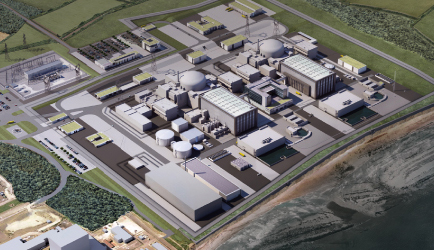I have mentioned in past blogs that nuclear power is being challenged from several directions. Cheap and abundant natural gas has made existing nuclear power less competitive and reduced demand for new nuclear power.. Renewables are getting cheaper and better every day. The nuclear industry has resorted to asking for price guarantees and claiming that they are a low-carbon source of electricity. Some states are considering designating nuclear power as a renewable resource because spent fuel can be reprocessed and more fuel extracted. The nuclear industry has also been striking back at some other sources of energy.
Although it has been cheap natural gas that has had the greatest impact on nuclear power, the nuclear industry has chosen to attack renewables instead. Nuclear power accounts for about twenty percent of the electricity generation in the U.S. and wind generates about four percent and solar generates about two tenths of one percent. Nuclear plant owners have lobbied successfully against renewable sources and energy efficiency standards in some states. They are trying to make changes in regional capacity markets that would retard adoption of solar and wind. The new standards would help nuclear power generators.
Nuclear and renewables often compete as states develop federally mandated “Clean Power Plans.” In deregulated states, nuclear has been having difficulty competing in the open market with natural gas but also wind power. Distributed solar generation systems have reduced demand for electricity from the grid. The energy system in the U.S. appears to be moving away from large centralized power plants which reduces the attraction of and support for nuclear power plants.
Supporters of nuclear energy have made exaggerated claims that nuclear power is steady and reliable. They say that nuclear fuel is the ultimate clean fuel with zero carbon emissions or the release of other harmful gases. With respect to carbon emissions, scientific studies have found that nuclear power does have a carbon footprint that may exceed natural gas plants if a low grade uranium ore is the source of fuel.
On the other hand, nuclear opponents talk about the health and safety risks of nuclear power plants. They worry about the long term cost of such things as decommissioning a nuclear power plant and disposal of nuclear waste. A major nuclear accident like Fukushima can cause billions of dollars in damages to the environment and impact the health of millions.
In Illinois, Exelon, operators of six nuclear power plants in Illinois, says that unless the state steps in with heavy subsidies to the tune of half a billion dollars, they will have to shut down three of their plants because they will not be competitive in the open energy market. Critics say that the state has already subsidized Exelon enough and that Exelon is exaggerating the problems at the three plants under discussion.
In Ohio, the renewables and energy efficiency standards were suspended by successful lobbying of FirstEnergy. FirstEnergy claimed that the existing standards were “distorting the marketplace” and costly to ratepayers. Now FirstEnergy is asking for ratepayers to be forced to pay a guaranteed rate for electricity for the Davis-Besse nuclear power plant near Toledo. Critics say that this three billion dollar gift to the nuclear industry will certainly distort the marketplace.
Analysts say that the nuclear industry is attacking renewables because they have no ability to affect the price or market position of natural gas. In addition, many utilities and power companies that own nuclear power plants also own coal, oil and/or natural gas power plants. In the energy marketplace, all sources of electricity are paid the same amount as the highest bid. When natural gas was expensive, nuclear benefited. Now that natural gas is cheap and cheap wind power is available, nuclear power is at a disadvantage because of the expense of operation. When nuclear power was subsidized, the nuclear industry thought that was fine. Now that solar and wind are getting subsidies, the nuclear industry lobbies against them. The truth of the matter is that nuclear power is more expensive than other sources and getting more and more expensive all the time. Nuclear power cannot compete on a level playing field. It should be retired as quickly as possible.
FirstEnergy Davis-Besse nuclear power plant:







